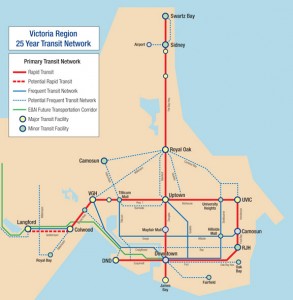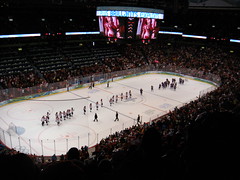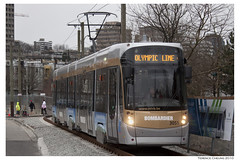A few days after I pointed that Toronto doesn’t get a cent from Ontario to run the TTC, “fiscal conservative” Mayor Rob Ford has gone cap in hand, like his predecessors, to ask for Ontario to restore the 50% operating subsidy, but by the “fiscal conservative” Premier Mike Harris. Like his predecessors, Ford failed. Ouch.
Category: Public Transit
“Surviving” public transportation
Ugh, yet another article on “Surviving Public Transportation“, as if it is something to be endured. One of the books they mention is My Kind of Public Transportation, which Jarrett over at Human Transit elegantly rips apart in his post about the Disneyland Theory of Transit.
However, given we are about to cut a few thousand hours from buses run here in Victoria, the federal NDP’s public transportation strategy cannot come soon enough. Now if only the newspaper could get the story right about BC Transit. The issue isn’t so much that the number of riders fell, it is that this is the first year in a decade that ridership hasn’t risen. That little fact, despite being easily seen in any slide-show from BC Transit, isn’t mentioned in either editorial or the main article about bus lanes.
Also, we are not the only region that got a higher than expected bill for buses. At least one Nelson councillor is publicly ruminating about “sending the buses back to the province” and “what about a Nelson-run transit system?” Lovely ideas, but they fail to realize two key points:
- BC Transit has a fairly good (by North American standards) deal with regards to sharing of operating costs on an even basis with the province and local authority. Pity the poor systems in Alberta, which much go cap in hand system-by-system, or the TTC, which gets no help from Ontario.
- BC Transit offers local communities centralized planning and purchasing, one of the reasons why BC has some of the best rural and small community transit in North America.
Lastly, the group that killed the last round of transit improvements on Douglas St, the Association of Douglas Street Businesses, is out to do it again, claiming we need to “rethink rapid transit.” Actually, they don’t want any rapid transit. Their spokesman, Bev Highton, said this:
Bev Highton commented that he felt that the committee did not include representation of people who use the roads every day, and there should be discussion on whether there is actually a need for Rapid Transit. He also had concerns about the guiding principles of securing a dedicated right of way.
(from the [download id=”7″ format=”1″] – CLC mandate and other minutes can be seen here). Take anything this group says with a giant grain of salt.
So in sum: The sky is not falling, buses are not horrible, the world will not end if we get a bus-only lane somewhere in the city, and the universe will not end if we get light rail.
Oak Bay posts Active Transportation Plan RFP
Want to help change the face of transportation in Oak Bay? The municipality is looking for a team to put together an active transportation plan. What should this plan address?
The main goal of the Active Transportation Plan is to enhance choices and opportunities and improve the usage of human-powered forms of travel and recreation within Oak Bay. It should also promote physical activity and healthy lifestyles for all ages and support green initiatives within the community.
What do you need to enter? Three hard copies of proposal marked “Active Transportation Plan Proposal” addressed to Loranne Hilton, Municipal Clerk, District of Oak Bay, 2167 Oak Bay Avenue, Victoria, B.C. V8R 1G2 on or before Friday, February 18, 2011 at 4:00 p.m. local time.
The full RFP can be download here: [download id=”6″ format=”1″] (PDF).
(Full disclosure: As a member of the Community Initiatives Committee that will be overseeing this plan, you cannot contact me with any details of any bid. To do so would be a bad thing and illegal.)
Opinion: BC Transit will be hard pressed to reject rail now
With both Victoria and Saanich councils coming out so strongly in favour of LRT along Douglas, I think BC Transit will find itself hardpressed to reject rail. It is pretty clear that senior BC Transit staff figure that Bus Rapid Transit, or BRT, is a better short-term bet, given the realities of provincial funding, but if they do decide on bus, they are going to have to explain themselves to hostile councils, wondering why their wishes were completely ignored.
Of course, the political calculus may change . There is a great deal of political instability at the provincial level, a minority government in Ottawa that may fall in the spring, and the upcoming Nov 2011 municipal election. So by the time that BC Transit goes cap-in-hand for funding, they may be talking to three completely different governments. May we live in interesting times indeed.
If you want to take a look at how all the various options might look, BC Transit has a very nice set of [download id=”5″ format=”1″]
Come have your say next week
Two different projects are seeking public input next week, although only one really connects to Oak Bay directly.
The first is the Oak Bay High Project, which is on a crazily-tight timeline to have shovels in the ground by this time next year, so they have scheduled a series of open houses on a potential “neighbourhood learning centre“, a relatively new concept the province is championing for using schools beyond school hours. This is where the space for the full theatre may come from, or a host of other options. What is at stake? The NLC can add 15% to the space of the school — some 1500 sq m in total.
Also seeking input is the latest stage of the BC Transit Victoria Regional Rapid Transit plan, which continues to confuse me with regards to the West Shore. The premier recently announced at the UBCM annual conference that Victoria’s rapid transit project was getting funded (with unknown monies), and the text of his speech says this:
We need to get the rapid bus launched in the capital regional district,
Which leave me confused. Because they have decided to use the E&N rail corridor in Langford and I just don’t see the Island Corridor Foundation and CRD Parks giving up on their dream of an E&N rail trail to allow buses to run beside the rail line (and the rail line is not going away. The ICF owns it outright and only they — meaning the collective municipalities and native bands along the line — can decide otherwise). And their consultations this week include “a showcase of rail and bus options.” So is the premier wrong is the or is something unexpected in the works?
So if you want to attend all of these open houses and workshops, your week would look something like this:
Sun: Oak Bay NLC consultation, 1pm – 3pm, Monterey Rec Centre, 1442 Monterey Ave
Tues: BC Transit Open House, 2pm – 7pm, Ambrosia Event Centre, 638 Fisgard St.
Oak Bay NLC consultation, 7pm – 9pm, Oak Bay Rec Centre, 1975 Bee St.
Thurs: BC Transit, 3pm – 8pm, Langford Legion, 760 Station Road
A night of fireworks and booze

A few days late, but I thought I would share a little bit of my evening on Canada Day. After my little walkabout to the various block parties, I braved the bus to head down to my brother’s for a bit of beer, pizza, and fireworks. While on the trip down I had a few deeply unpleasant experiences with a drunk girl who was extremely aggressive to both me and the poor lady sitting next to me. This made me understand why BC Transit chooses to ban alcohol on the buses on Canada Day, but I am very hesitant to support such a position given I believe it to be unconstitutional.
Interestingly, while the bus was emptied near downtown for a search for alcohol, I ran into Manuel Achadinha, whose day job is CEO of BC Transit. He was out being a transit supervisor for the day on the “worst night of the year” and ,according to another supervisor I spoke to just before midnight, he was still out there. Kudos to him for seeing and helping with what the front line staff (drivers and supervisors) have to deal with.
I got a few pictures of the fireworks and the masses of people (Government St. in front of the Empress was completely packed until about 11pm), so enjoy:
[slickr-flickr tag=”canadadaynight2010″ items=”10″ type=”gallery”]
(These can also be seen in my flickr set)
BC Transit talks its future

With the Victoria Regional Rapid Transit planning coming along and the province-wide 2030 strategic plan just finished, BC Transit held a pair of workshops recently to discuss their latest planning endeavour: The Victoria 2035 “Transit Future” as well as a status update on the rapid transit plan itself. I managed to miss the first meeting at Victoria City Hall on Monday so I was forced to make the trek out to suburban hell (aka the Westshore) to see what the fuss was all about.
It seems I managed to time my visit just right, as I managed to hit a lull in traffic and thus had the nearly undivided attention of several senior BC Transit staff, including the CEO Manuel Achadinha. This also meant I was blissfully free of the “rail ranters” who like to show up to these events and are convinced that the reason Victoria doesn’t have rail is a giant conspiracy theory that can only be solved by ranting at whatever poor transit staff that happens to be in front of them.
With the corridor nailed was nailed down a few months back, the rapid transit planning people were asking for feedback on detailed placement within the alignment (median vs curb-side) and type of vehicle (from buses to rail of all kinds). After those have been made, detailed costing analysis needs to be done. It was stressed to me that this will include capital and operating costs. I can only hope that the marketing and messaging works around this so that the “buses are cheaper” meme doesn’t rear its ugly head. The final report is due by the end of this year or early next, to match the 2011 federal and provincial budget cycles.
Beyond the rapid transit project is the Frequent Transit Network, lacking a catchy title or separate branding, but it “aims to provide a network of all-day, every day routes with a 15 minute minimum service, 15 hours a day, 7 days a week.” The new 15 UVic/Downtown Express (nee Dogwood Line) and the upcoming 16 Express (nee 26A, details can be found in the 2010/11 Service Plan [PDF, pg 2]) are part of this network, as are more traditional buses such as the 6 and 14.
I am glad I braved the six lanes of traffic on the Old Island highway plus being stuck in rush hour traffic on McKenzie to get there. I am cautiously optimistic that something may come of the rapid transit project because of BC Transit’s excellent recent track record with the new express buses and service expansion. However, this work may make me more hopeful than maybe a should be. After all, there are a lot of old, dusty reports listed on this page alone. If you want to add your voice to see such a bright future, check out the Community Consultation page under the June 2010 heading. Maybe some of our voices will be heard at the senior levels of government.
An Olympic experience
Courtesy of a good friend, a bunch of us went over on the weekend to see Canada’s Women Hockey Team play Slovakia. It was the game where the poor Slovakians lost 18-0 and were outshot 67-9.

To start off, I have to give massive credit to the Slovakian goalie, who really did try. She made some amazing saves but in the end it just wasn’t enough. At one point they had literally just finished announcing who had scored the last goal when the next one went in. The Slovakians also had some good chances, mostly because the Canadians were incredibly sloppy while passing in their own end. The crowd was pretty amazing, applauding the Slovakian goalie every time she made a great save (she made a lot of those) and at the end of the game giving the entire Slovakian team a standing ovation. The Canadian team was also gracious enough to simply skate off at the end, without receiving the same.
But before we even sat down for the game, we already had a bit of fun with venues. The website listed both Thunderbird Stadium at UBC and Canada Hockey Place (ex-GM Place) as the venue, so when we arrived at Thunderbird Stadium for the game we were rather rudely surprised to learn we had gone to the wrong place. Amazingly, there is no direct bus connection between the UBC and Hockey Place. So off on a quest we went, one bus and two Skytrain rides later, arriving shortly before the 5pm start. Or was it the 4:30pm start. The website and our tickets disagreed on that too.
Which brings us to security. The reason we were two hours early in getting to UBC was for the expected security, a saving grace and it turned out. Processing 18,000 fans into a stadium in a short period of time is hard but it ran fairly smoothly, even if it took the better part of 45 minutes standing in the concrete jungle that is the Georgia/Dunsmuir Viaducts and Skytrain line. After the game we set off to see the Olympic torch, which was by that point very neatly blocked off with an elegantly-designed barrier of 10′ of chain-link fence and concrete. Gulag chic was definitely in.
Transit was one of the bright spots of the whole day. The bus was busy, but not overly so. Of the many Skytrain trips we took, on all three lines, there were usually seats. I shudder to think what it would have been like without trains running on 90 sec headways and all those new cars that Translink purchased recently for the Expo/Millenium Lines. However, I really wonder just how much VANOC paid Translink for all the extra service. Too bad VANOC is beyond FOI reach. They claim they are going to release their budget after the games, so we will know eventually.

Aside from seeing the game, I also wanted a chance to ride the Brussels- and Bombardier-supplied streetcar running on the new track between the Olympic Village Canada Line station and Granville Island. Thanks to the good transit connections, I managed it. It was smooth, clean, and quite busy even at nearly 9pm when we rode it. Apparently earlier in the day it had been packed. The car also had a pleasant odour of brand-new leather, coming from the hanging straps. Made a nice difference from the usual smells you can run into on older transit buses and trains.
We were fortunate enough to have a relative of one of my friends to stay with in Vancouver, so we didn’t have to find some of the very scarce hotel space available. They also lived in a decent place for transit, so we could get to and from their place without too much difficultly. Attempting to drive down would have been insane and impossible and there are few park-and-rides anywhere on the Skytrain system.
I am glad I had a chance to go and see the Olympics and all the effects it has had on Vancouver. I really hope that the City of Vancouver finds some way to keep the Olympic Line running, although they will need to find new vehicles. Not reopening the Georgia and Dunsmuir viaducts would also go a long way to making the downtown a better place. As for the rest of the legacy of the games, that remains to be seen.
What exactly did the reporter mean?
In the latest Times Colonist article about fares going up, there is this line (emphasis mine):
The commission is facing major capital expenditures in coming years, including bus replacement and development of rapid transit involving buses.
And here I was thinking that the decision on mode type hadn’t been made yet. Silly me.
Just how bad are the transit cuts?
As I have mentioned here many times, BC Transit is one of the few transit agencies in North America not currently cutting service. How bad are those cuts? Here is a map of US transit cuts compiled by Transportation for America:
View United States of Transit Cutbacks in a larger map
What about Canada? Calgary is cutting service, but that was only the one I could find good information about. Ottawa narrowly avoided cutting services, as did Vancouver & Toronto, while Montreal is staring potential cuts in the face. Those that didn’t cut service often did so by raising fares, which will drive ridership away just as surely as cuts will. Overall 2010 looks to be a pretty grim year, although public outrage will likely not appear, as the Transport Politic points out. Transit cuts that were avoided this year will likely come next year, as rising gas further drives cost up. Get ready for a bumpy ride.